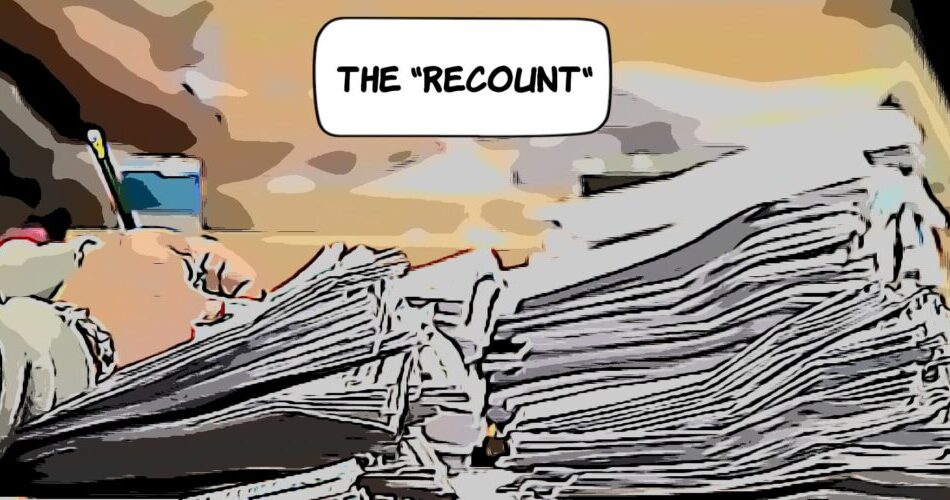Cast Vote Records are difficult to obtain in Washington State. Recent legislation declared them exempt from public disclosure. We have been documenting these requests and you can learn about them HERE. Despite this, we were provided a copy of the Skamania County 2022 general election cast vote record. It was provided in a pdf format, which was spread out over several pages and difficult to follow. After converting it into a spreadsheet, an analysis was conducted focusing on one race at a time. This article will cover the US Senator, State Representative Position 1 and 2, County Commissioner 3, and the Skamania County Sheriff races. Then we will focus on the US Representative District 3 race, which was Joe Kent and Marie Gluesenkamp Perez.
The cast vote record allows us to see how the votes were tabulated for each race. There is nothing that identifies a voter, nor does it contain any personal information or information which would risk the security of the system or the secrecy of the ballot. It’s a replay of the vote counting process.
The Races
Skamania County is a consistently conservative county. It was not surprising that Tiffany Smiley, the Republican, won the US Senator race within the county. The total margin of victory was 979 votes, which was also the largest lead she had at any point during the tabulation. She took the lead from the beginning, and it grew as time went on and more ballots were added to the count. There are some similarities in this race that we have seen before, like the fact that the Republican candidate did better during the second half of tabulation than the earlier ballots counted.


Kevin Waters, who ran for state representative position 1, received the most votes in Skamania County, excluding the uncontested races. His final margin of victory was 1907, a significant amount for such a small county.
Position 2 was won by Paul Harris, who received the second most votes among all candidates excluding uncontested races with a margin of victory of 1,153. It seems these state representative races were of more interest to Republican voters than the national races.


The Commissioner race looks an awful lot like the US Representative race. Asa Leckie was declared the winner, but it was back and forth for the first half of the race, similar to Joe Kent. The most she was down at any points was 88 votes, but she ended up winning by 574 votes.
The Sheriff race was the closest race in the county. There were two Republican candidates running. It was extremely close the entire way. The final margin of victory was just 25 votes. Summer Scheyer was at one point losing by 38 votes, and at another point was ahead by 63 votes. It’s difficult to tell the two lines apart on the first graph because they are right on top of each other the whole way. The lead switched something like 35 times for this race, back and forth.


Joe Kent’s race, like the Senator race, received national media attention and he was expected to win the third district. You can read more about that HERE, where we analyze the Cowlitz and Lewis County data from the 2022 primary and general elections.
Kent ends up with a margin of victory of 394 more votes than Perez. What is interesting is that for the first half of the election, Perez was in the lead. She was up 119 votes at one point. Then during the second half of vote counting, Kent finished strong and held the lead.
Comparing Races
Another head scratcher: Why did Joe Kent receive the least number of votes for all races which had both a Democrat and Republican running? It appears he was the least favorite Republican candidate, which is difficult to believe. He got more total votes than a couple Republicans, but only the ones where two Republicans were running against t each other.

The graph below shows the percentage of Joe Kent’s votes for his race. It shows the first half of the ballots counted were favoring his opponent and the second half of the ballots were favoring him. Perez was leading from the 2nd through the 7th, until Joe Kent took back the lead and won the race in this county.

2020 vs 2022


When comparing the 2020 and 2022 district 3 races, they are almost identical. There are just fewer total votes, probably because 2020 had more attention due to the presidential race on the ballot. This is concerning. How would the votes have come in the same way in 2020 as they did in 2022 with 4 completely different candidates? The person who won in 2020 lost in the 2022 primary, so neither candidate was an incumbent.

![]()
Adjudication Rate
The cast vote record can potentially show signs of manipulation. For example, there may be an abuse of adjudication favoring one candidate or certain precincts. There may also be obvious ballot box stuffing very early in the election or very late in the election, as we have seen before.

After reviewing these materials, we can rule out fraud through excessive adjudication. The adjudication rate is reasonable and doesn’t favor any particular candidate. The distribution of votes for the adjudicated (remade) ballots fell within the average distribution between each race. It doesn’t appear any batches of ballots were scanned multiple times. There was no after-hours scanning.
Accuracy of the Results
We will never be able to confirm if the machine counted the votes accurately without seeing the paper ballots. The scanner could be manipulated to switch the location of the bubble on the ballot image, as Dr. Alex Halderman explains in his report titled Unclear Ballot. Because those are commercial off the shelf products, and their vulnerabilities are widely known, there is still risk that the information being fed to the tabulator has already been manipulated.
This would be evident in a hand recount, but not through a machine recount or post-election audit. Often when the ballot image is saved, there is no need to look at the actual ballot again. In machine recounts, they only look at ballot images and only of the ones recorded as undervotes.
Fraud Options Outside of the Machines
There are many ways an election or a race can be influenced. Machine fraud and internet access get the most attention. However, there is another possibility that has nothing to do with the tabulation machines. The daily ballot status report can be used to calculate how many votes were needed according to who has returned a ballot.
This is not a theory, there are companies out there that use data mining and analysis to map out the landscape with the voters using social media and other available information to determine our party preference and which way we lean on certain issues. They will sell this information to campaigns and probably anyone willing to pay for it. L2 is an example of one such company right here in Bothell, Washington. Once you know where the voters stand, and you know who has already voted, you can approximate the current vote counts and decide if more are needed to swing the race, ensure one candidate wins, or make sure the totals are outside of recount range.
The good news is, it looks like Skamania County ran a clean election, at least for the parts they have control over. The bad news is that we cannot rule out fraud within the machines or by ballot box stuffing/monitoring the ballot statistics to track the results and mule in more ballots.
Unanswered Questions
1. Why do the early ballots favor the Democrats in 2020 and 2022?
2. Why did the votes come in the same pattern as they did in 2020?
3. Do the paper ballots really match the machine’s tally?
4. Can the voters and ballots be authenticated?
Looking Ahead
Kent indicated he plans to run again in 2024. Which means the people in District 3 would be spending time wisely canvassing that area and submitting voter challenges to clean the rolls. The Washington Audit Research Team has put together some tools to get started. To learn more, please CLICK HERE. Until the rolls are accurate, there will be excess ballots circulating which are subject to being harvested and illegally submitted.
As for us, we will continue investigating the issues with the election process and informing the public on our findings.
The Data
Below is a copy of the cast vote record that was provided. There is another report as well, which is what we used for time reference.



